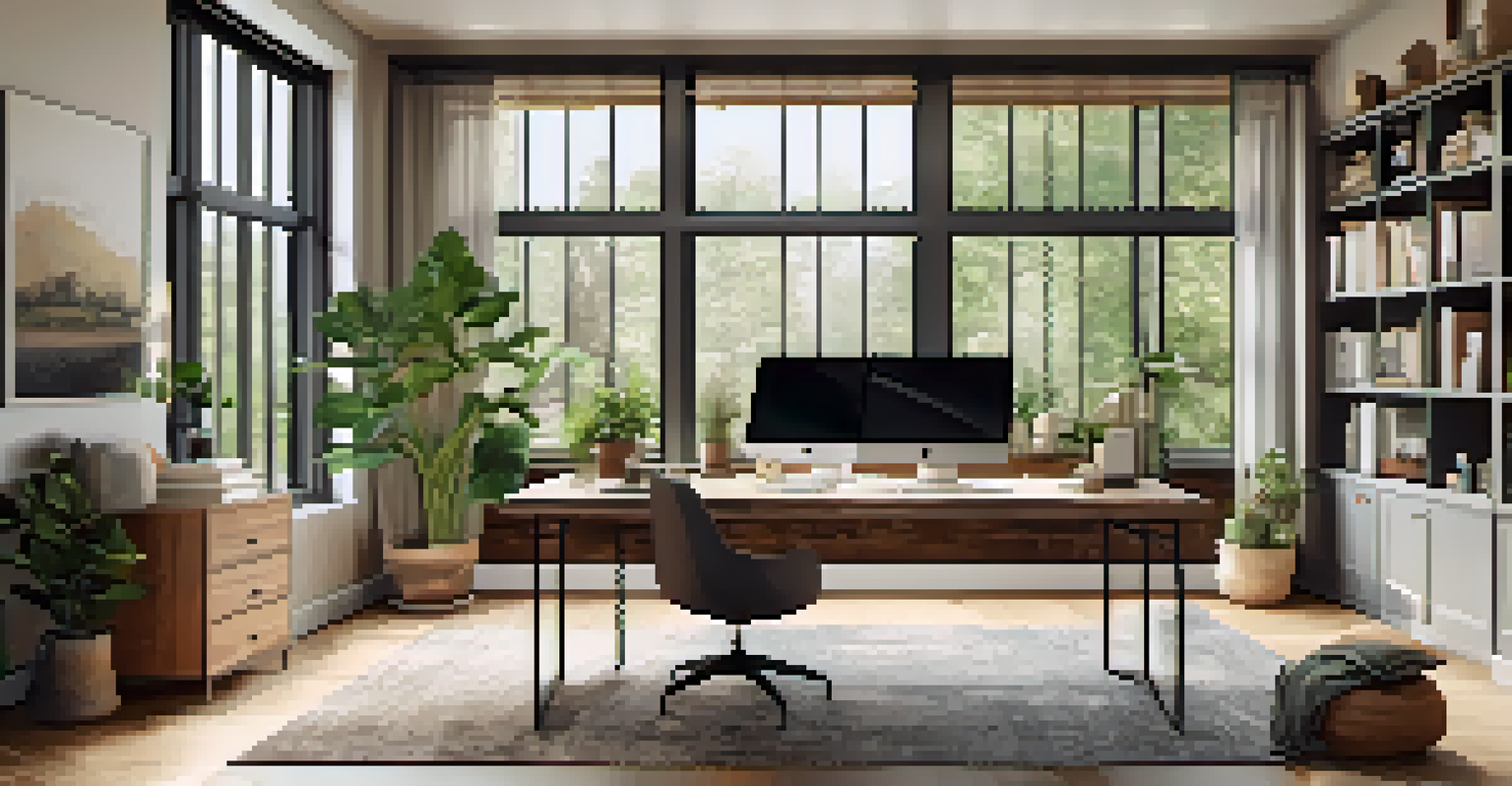Remote Work's Impact on Real Estate Market Recovery Post-Pandemic

Remote Work: A Game Changer for Housing Demand
The shift to remote work has fundamentally shifted where people want to live. Many are leaving crowded urban centers for quieter suburban or rural areas, seeking more space and a better quality of life. This change in demand is reshaping the real estate landscape, as buyers prioritize home offices and larger living spaces.
Remote work is not just a trend; it’s a fundamental shift in how we think about work and life.
For instance, a family that once thrived in a bustling city may now find joy in a spacious home with a backyard and a dedicated workspace. This trend has led to increased competition in these previously less sought-after areas, driving up property prices. As a result, real estate markets in these regions are witnessing a remarkable recovery.
Moreover, developers are now responding to this demand by creating homes that cater specifically to remote workers, featuring high-speed internet access and designated office spaces. This shift not only boosts local economies but also revitalizes the real estate market overall.
Urban Exodus: The Rise of Suburban Living
As remote work became the norm, many individuals and families opted to flee the city life, contributing to an urban exodus. This trend was fueled by the desire for more space, lower costs, and a peaceful environment, making suburbs and rural areas increasingly attractive. Consequently, this shift has sparked a resurgence in suburban real estate.

The COVID-19 pandemic highlighted the downsides of urban living, such as higher density and limited outdoor space, pushing people to seek homes that accommodate their new lifestyles. For example, cities like New York and San Francisco have seen significant declines in rental prices while suburban areas are booming with sales.
Remote Work Fuels Suburban Growth
The shift to remote work is driving demand for suburban and rural homes, as people seek more space and a better quality of life.
This movement not only impacts housing prices but also influences local businesses and community development. As more people flock to these areas, local services and amenities are adapting to meet the growing demand, resulting in an overall positive economic effect.
Changing Preferences: What Buyers Want Now
The pandemic has altered buyer preferences, with features such as home offices and outdoor spaces now topping the list. Buyers are looking for homes that support their new work-from-home lifestyle, leading to a shift in what is considered 'desirable' in real estate. This means that properties with flexible spaces or dedicated offices are now more sought after.
The future of work is flexible, and so too must be our approach to housing and living spaces.
Additionally, many are prioritizing homes with access to nature, like parks or trails, as people increasingly value relaxation and wellness. This preference for health-oriented living spaces has led to a marked increase in demand for properties featuring gardens or proximity to green spaces.
Real estate agents are now advising sellers to highlight these features in listings. As a result, homes that cater to these new preferences are selling faster and at higher prices, demonstrating the significant impact of remote work on buyer behavior.
Investors Shift Focus: From Urban to Suburban Properties
With the rise of remote work, real estate investors are adapting their strategies, shifting focus from urban to suburban properties. This change is driven by the growing demand for homes in less populated areas, where potential returns on investment are becoming increasingly attractive. Investors recognize the chance to capitalize on this trend by purchasing properties in emerging neighborhoods.
For instance, many investors are now looking at suburban markets that offer affordability and space, which were previously overlooked. The appeal lies not only in the lower entry prices but also in the potential for high appreciation as more people move to these areas.
Buyers Prioritize Home Features
Homebuyers are now looking for properties with dedicated office spaces and access to nature, reflecting their new work-from-home lifestyles.
As a result, new developments and renovations in suburban areas are on the rise, leading to economic growth and revitalization. This investment influx is helping to support the recovery of the real estate market in these regions.
The Rental Market: Adapting to New Realities
The rental market has also felt the impact of remote work, leading to shifts in tenant expectations and landlord strategies. With more people working from home, renters are seeking accommodations that provide flexibility and comfort. This has resulted in a greater demand for longer-term leases in suburban areas, as opposed to short-term city rentals.
Landlords are now focused on enhancing properties by adding features that appeal to remote workers, such as high-speed internet and dedicated workspaces. This adaptation not only meets tenant needs but also helps landlords retain tenants in a competitive market.
Furthermore, as the vacation rental market experiences a downturn due to decreased travel, many property owners are pivoting to traditional long-term rentals. This shift reflects the broader changes in lifestyle and work arrangements, further emphasizing the influence of remote work on the real estate sector.
Technology's Role in Facilitating Remote Work Housing
Technology has played a crucial role in enabling remote work and influencing the real estate market. Virtual tours, online listings, and digital transactions have become the new norm, allowing buyers and renters to explore properties from the comfort of their homes. This accessibility has broadened the reach for both sellers and buyers, making it easier to navigate the market.
Moreover, the rise of remote work tools has led to an increased focus on smart home features. Buyers are now looking for homes equipped with technology that enhances their work-from-home experience, such as smart thermostats and security systems. Real estate agents are leveraging these technologies to offer a more seamless and engaging home-buying experience.
Investors Shift to Suburban Markets
Real estate investors are increasingly focusing on suburban properties, recognizing the potential for growth and appreciation in these areas.
This technological shift not only benefits individual buyers but also helps real estate professionals adapt to changing market conditions. As the industry embraces these advancements, it positions itself for a more dynamic and responsive future.
The Future of Real Estate: Hybrid Work and Its Effects
As businesses contemplate the future of work and a hybrid model becomes more prevalent, the real estate market is poised for further transformation. Remote work is likely here to stay, and this will continue to shape where people choose to live, work, and invest. The flexibility of hybrid work arrangements means that location is less tied to employment, allowing for a more diverse range of housing options.
This evolving landscape suggests that the suburbs may continue to thrive, but urban areas will also adapt to attract residents. Cities may need to rethink their offerings, focusing on creating vibrant communities that appeal to those who still want the urban experience but with the added benefit of flexibility.

Ultimately, as remote work continues to redefine the workforce, the real estate market will need to evolve in tandem. By staying attuned to these changes, both buyers and sellers can navigate the recovery phase successfully.